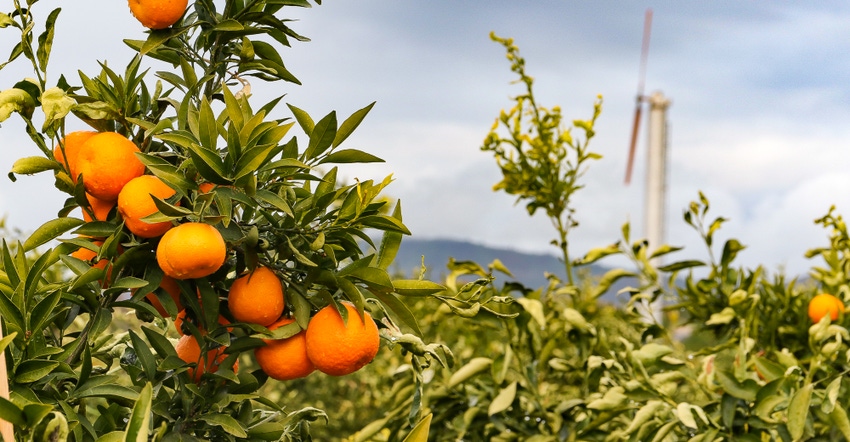
Fresno County, Calif. crop values nearly returned to record territory in 2017, almost erasing nearly $1 billion in gross agricultural receipts starved from the economy the previous two years by severe drought.
Coming off a banner water year in the winter of 2016-17, Fresno County farmers grossed over $7.028 billion for the crops they produced, according to the annual crop report published by Fresno County Agricultural Commissioner Les Wright.
Wright’s annual report to county supervisors has a long tradition of trumpeting the economic input agriculture has to the county’s economy. As the only San Joaquin Valley county to stretch the width of the Valley, farmers here can produce about 400 different commodities, including fruits, vegetables, livestock, nuts and timber.
Long the nation’s leading agricultural county by gross receipts, Fresno County slipped to third place in 2014 behind Tulare and Kern counties due to several factors. Those included record-high milk prices that bolstered the value of Tulare County’s dairy industry, increases in pistachio and almond production that benefitted Kern County, and the regulatory constraints on surface irrigation that eroded western Fresno County’s vegetable and cotton plantings.
Beneath the large numbers remains an industry that daily and “unceremoniously” provides millions of meals to a global marketplace, says Fresno County Farm Bureau Chief Executive Officer Ryan Jacobson.
“Whether your job depends on agriculture or not, the consequences of this report affects your daily life,” Jacobson said.
Jacobson further noted that some growers in early 2017 were forced to idle some farmland as federal water officials failed to make water allocation predictions prior before planting decisions needed to be made.
Cattle industry
Each year Wright likes to highlight a segment of the agriculture industry in his report. This year that facet was the cattle industry, which can be traced back to the Spanish missions that settled California long before statehood was granted.
Mark Thompson, president of the Fresno-Kings Cattlemen’s Association, said the cattle industry in Fresno County remains a significant part of the county’s overall crop value with the inclusion of Harris Ranch on the western edge of the county. Cattle production in the county also requires locally-produced feed commodities, and is responsible for many jobs, Thompson said.
The combined value of dairy and beef cattle and calves sold in Fresno County in 2017 was over $420 million.
Top crops
Almonds, grapes and poultry top the list of most valuable commodities produced in the county. For the most part, poultry – turkeys, chickens, ducks, geese and gamebirds – are produced for their meat, though the crop report does list egg production under the category.
About 20 percent of the state’s almond crop is grown in Fresno County. The 258,000 tons of almonds grown there in 2017 sold for over $1.1 billion. Over one-quarter of that volume was exported to foreign markets.
Almond acreage climbed about 13,000 to over 228,000 acres. Almond yields in 2017 averaged 2,260 pounds per acre. Prices remained little-changed from the previous year.
In all cases, dollar values are listed as gross figures and do not reflect grower profits or economic impacts to the county.
Fresno is one of the few locations that grows grapes for wine, table and raisins. Much-improved grape prices from the previous year pushed the value of all grapes in the county to over $935 million.
Of those uses, wine grapes saw a 21 percent reduction in harvested acreage. Anecdotal reports among those in the grape industry suggest wine grape farmers are converting to almonds and pistachios, which yield better returns. Table grape acreage remained little-changed while those grown for raisins saw a slight increase in harvested acres.
Pistachios remain a popular crop for growers, though profitable returns there take longer to generate than with almonds as the first pistachio crop tends not to happen until seven years after planting.
Nevertheless, harvested acres of pistachios grew over 8 percent to more than 101,000 acres. Average yields were down 22 percent to 2,380 pounds per acre in the alternate-bearing crop as the average price was up 144 percent to $2.13 per pound to the grower.
At the Tuesday meeting where Wright presented his crop report, Fresno County Supervisor Buddy Mendes said farmers able to harvest pistachios early this year could see bonus checks as the Wonderful Company recently indicated a shortage of pistachios and is willing to pay a premium to growers the first two weeks of harvest just to get nuts in the sales pipeline.
One nut marketer said the industry in general is currently short on good-quality pistachios and most processors are willing to pay an additional 3-5 cents per pound for early harvest nuts.
Pistachios and mandarins remain fast-risers on the crop report. At No. 4 in value ranking in 2017, pistachios moved up three spots from the previous year while mandarins made their first appearance in the top-10 at No. 6, pushing garlic out of the 10 highest-valued crops.
Mandarin acreage in 2017 climbed 27 percent to over 23,000, closing in on the total acreage of various orange varieties at 28,811 acres.
Most notable in mandarins was the 111 percent increase in price to over $1,600 per ton on 267,000 tons of total production.
The Fresno County Crop Report can be viewed online.
About the Author(s)
You May Also Like






